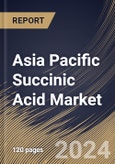Succinic acid (SA), also called butanedioic acid, is a naturally occurring dicarboxylic acid found in various living organisms. It is a pivotal intermediate in the tricarboxylic acid (TCA) cycle, playing a crucial role in cellular metabolism. Chemically, it is a colorless crystalline solid with a slightly acidic taste, making it a valuable component in the food and pharmaceutical industries. In recent years, succinic acid has garnered attention as a platform chemical due to its potential in producing bio-based materials and polymers.
Moreover, it is increasingly utilized in pharmaceutical, construction, and infrastructure development, contributing to the expansion. It is manufactured using bio-based and petroleum-based materials. It is expected that the growing preference for succinic acid over butane-based maleic anhydride in the production of chemicals traditionally manufactured from butane, including succinic anhydride, plastics, diethylmaleate, polymers, fumaric, and glyoxylic acid, will have a positive impact on market growth.
According to the Ministry of Economy, Trade and Industry (METI) report updated in 2021, Japan's cosmetics and personal care industry was valued at approximately $35 billion in 2019. Skincare products are used by 53% of the Japanese cosmetics industry. It can be a natural additive in various cosmetics, contributing to product stability and performance. Its use aligns with the trend towards clean beauty and the demand for cosmetics with minimal synthetic additives. Due to the aforementioned factors the market growth will drive in this region.
The China market dominated the Asia Pacific Succinic Acid Market by Country in 2022, and would continue to be a dominant market till 2030; thereby, achieving a market value of $37,302.9 Thousands by 2030. The Japan market is experiencing a CAGR of 9.6% during (2023 - 2030). Additionally, The India market would exhibit a CAGR of 10.9% during (2023 - 2030).
Based on Type, the market is segmented into Petro-based, and Bio-based. Based on End-use, the market is segmented into Industrial, Food & Beverages, Coatings, Pharmaceutical, Personal Care & Cosmetics, and Others. Based on countries, the market is segmented into China, Japan, India, South Korea, Singapore, Malaysia, and Rest of Asia Pacific.
List of Key Companies Profiled
- BASF SE
- Parchem – Fine & Specialty Chemicals
- The Dow Chemical Company
- Mitsubishi Chemical Holdings Corporation
- Nippon Shokubai Co., Ltd.
- Roquette Freres SA
- Spectrum Chemical Mfg. Corp (Spectrum Laboratory Products, Inc.)
- The Chemical Company
- Ernesto Ventos S.A.
- Anhui Sunsing Chemicals Co., Ltd.
Market Report Segmentation
By Type (Volume, Tonnes, USD Million, 2019-2030)- Petro-based
- Bio-based
- Industrial
- Food & Beverages
- Coatings
- Pharmaceutical
- Personal Care & Cosmetics
- Others
- China
- Japan
- India
- South Korea
- Singapore
- Malaysia
- Rest of Asia Pacific
Table of Contents
Companies Mentioned
- BASF SE
- Parchem – Fine & Specialty Chemicals
- The Dow Chemical Company
- Mitsubishi Chemical Holdings Corporation
- Nippon Shokubai Co., Ltd.
- Roquette Freres SA
- Spectrum Chemical Mfg. Corp (Spectrum Laboratory Products, Inc.)
- The Chemical Company
- Ernesto Ventos S.A.
- Anhui Sunsing Chemicals Co., Ltd.
Methodology

LOADING...








